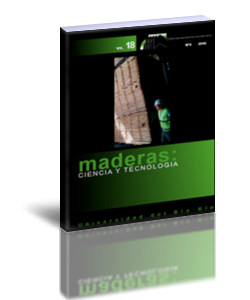Gasificación del aserrín de pino (Pinus arizonica) en un reactor de lecho fluidizado: Análisis de las variables del proceso
Keywords:
Biomasa forestal, modelación, proceso termoquímico, reactor químico, simulación, Chemical reactor, forest biomass, modeling, simulation, thermochemical process.Abstract
La gasificación hidrotérmica del aserrín de pino (Pinus arizonica) es un proceso de degradación termoquímica de sus macromoléculas poliméricas con el fin de producir principalmente hidrógeno y metano como biocombustibles. Este proceso puede ocurrir en un reactor de lecho fluidizado que permite un apropiado contacto gas-sólido, el adecuado manejo de la temperatura y una mayor velocidad de reacción. El propósito es modelar y simular las variables del proceso donde se gasifica esta biomasa forestal a partir del respectivo análisis de sensibilidad. Se obtiene que la conversión de reacción de gasificación del aserrín de pino crece a una temperatura mayor a los 900 °C, presentando un comportamiento que tiende a ser isotérmico, por lo que se sugiere un proceso energéticamente autosostenible. A su vez, la reacción mejoró para una alimentación de aserrín de pino con un diámetro óptimo de tamaño de partícula de 0,65 mm; se ve favorecida para bajas relaciones de vapor de agua/ biomasa alimentada alcanzando el óptimo en 2,375; y a bajas relaciones aire/biomasa con un valor óptimo de 0,289. Se evidencia que este proceso constituye una vía de aprovechamiento energético a partir de la conversión termoquímica de estos desechos y residuos forestales.
The hydrothermal gasification of sawdust pine (Pinus arizonica) is a process of thermochemical degradation of polymeric macromolecules in order to produce mainly hydrogen and methane as biofuels. This process can occur in a fluidized bed reactor which allows an appropriate gas-solid, proper temperature management and a faster reaction. The purpose is to model and simulate process variables where this forest biomass is gasified from the respective sensitivity analysis. It is obtained that the conversion of gasification reaction of pine sawdust increases at temperature higher than 900°C, showing a behavior that tends to be isothermal, suggesting an energetically self-sustaining process. In turn, it improved reaction for pine sawdust feed with an optimum particle size diameter of 0,65 mm; it is favored for low ratios steam / biomass fed in reaching the optimal 2,375; and at low air / biomass relationship with an optimum value of 0,289. It is evident that this process is a way of harnessing energy from thermochemical conversion of these wastes and forestry residues.
Downloads
References
Antal, M.; Allen, S.; Schulman, D.; Xu, X.; Divilio, R. 2000. Biomass gasification in supercritical water. Ind Eng Chem Res 39:4040-4053.
Beraldo, A.; Balzamo, H. 2009. Compuestos no-estructurales de cementos comerciales y aserrín de maderas argentinas. Maderas-Ciencia y Tecnología 11(3):233-250.
Durán-García, M. E. 2014. Reactores de lecho fluidizado y lecho burbujeante en la gasificación de biomasa residual. Revista Fuentes El Reventón Energético 12:35-43.
Fang, Z.; Minowa, T.; Fang, C.; Smith, R., Inomata, H.; Kozinski, J. 2008. Catalytic hydrothermal gasification of cellulose and glucose. International Journal of Hydrogen Energy 33:981-990.
Guo, L.; Lu, Y.; Zhang, X.; Ji, C.; Guan, Y.; Pei, A. 2007. Hydrogen production by biomass gasification in supercritical water: A systematic experimental and analytical study. Catalysis Today 129:275-286.
Kojima, T.; Assavadakorn, P.; Furusawa, T. 1993. Measurement and evaluation of gasification kinetics of sawdust char with steam in an experimental fluidized bed. Fuel Procces Technol 36:201-207.
Kumar, A.; Jones, D.; Hanna, M. 2009. Thermochemical Biomass Gasification: A Review of the Current Status of the Technology. Energies 2:556-581.
Kunni, D.; Levenspiel, O. 1991. Fluidization Engineering, 2nd ed. 491p.
Lee, J.; Kim, Y.; Lee, W.; Kim, S. 1998. Coal Gasification Kinetics derived from pirolysis in a fluidized bed reactor. Energy 23:475-488.
Lee, G.; Nunoura, T.; Matsumura, Y.; Yamamoto, K. 2002a. Global kinetics of 2- chlorophenol disappearance with NaOH in Supercritical Water. J Chemical Engineering of Japan 35:1252-1256.
Lee, I.; Kim, M.; Ihm, S.K. 2002b. Gasification of glucose in supercritical water. Ind Eng Chem Res 41:1182-1188.
Lu, Y.; Guo, L.; Ji, C.; Zhang, X.; Hao, X.; Yan, Q. 2006. Hydrogen production by biomass gasification in supercritical water: A parametric study. International Journal of Hydrogen Energy 31:822-831.
Lu, Y. ; Guo, L. ; Zhang, X. ; Yan, Q. 2007. Thermodynamic modeling and analysis of biomass gasification for hydrogen production in supercritical water. Chemical Engineering Journal 131: 233-244.
Lu, Y.; Jin, H.; Guo, L.; Zhang, X.; Cao, C.; Guo, X. 2008. Hydrogen production by biomass gasification in supercritical water with a fluidized bed reactor. International Journal of Hydrogen Energy 33:6066-6075.
Nikoo, M.; Mahinpey, N. 2008. Simulation of biomass gasification in fluidized bed reactor using Aspen Plus. Biomass and Bioenergy 32:1245-1254.
Ramakers, B.; Riddet, R.; Kerkhop, P. 2004. Fluidization behavior of wood/sand mixtures. Maderas-Ciencia y Tecnología 6:145-153.
Soto, G.; Nuñez, M. 2008. Fabricación de pellets de carbonilla, usando aserrin de pinus radiata (D. Don), como material aglomerante. Maderas-Ciencia y Tecnología 10(2):129-137.

































